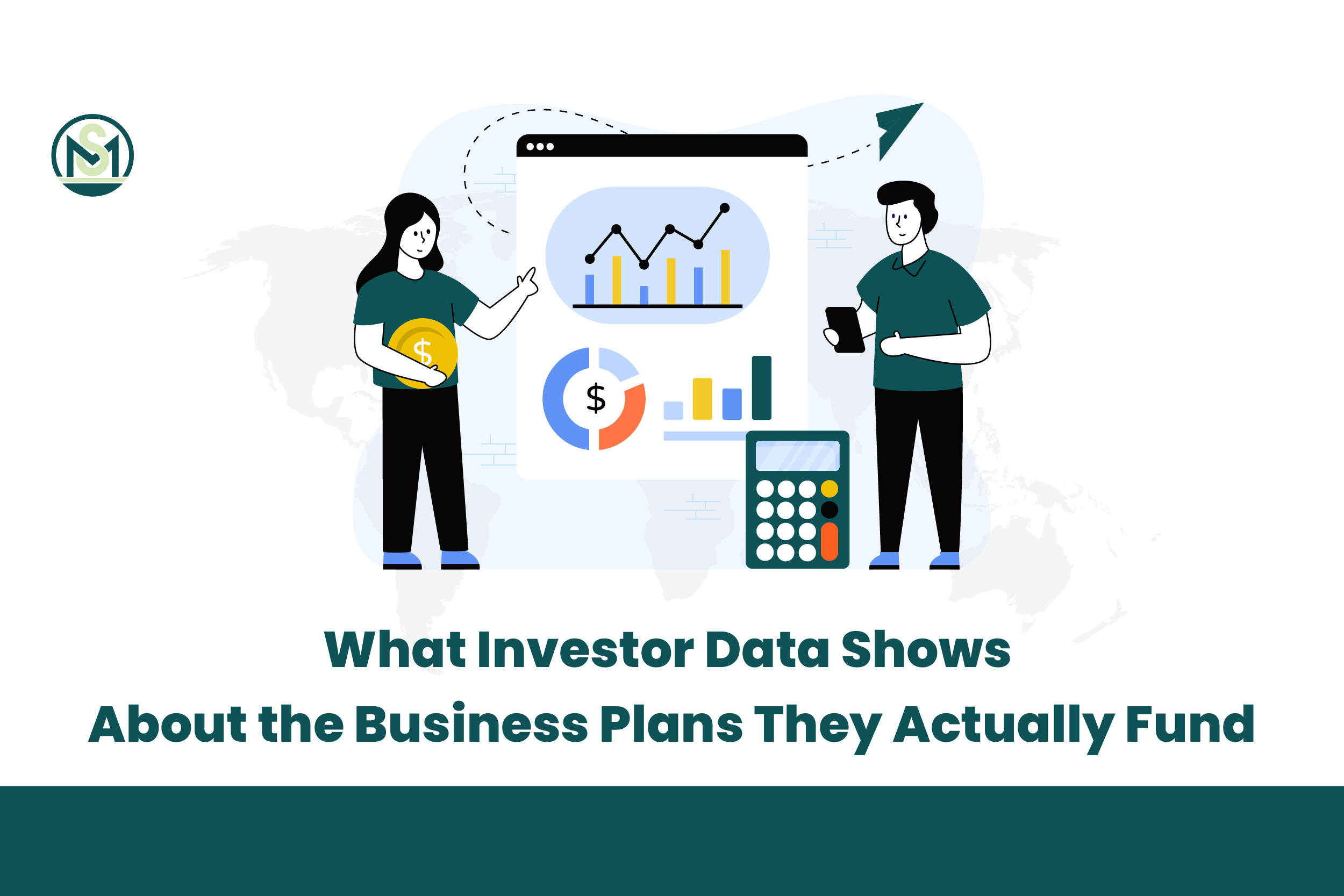Every startup founder dreams of pitching their idea to investors and walking away with funding. But here’s the harsh reality: most business plans never get funded. The real question is, why do some plans attract capital while others are ignored?
The answer lies in investor data insights. By studying how investors behave, what they prioritise, and the actual business plans investors fund, we can see clear patterns. These patterns aren’t just numbers on a spreadsheet; they reveal what investors value most when deciding whether to back a startup.
This article explores those insights in depth, breaking down the investment decisions data, the investor preferences in funding, and the business plan evaluation criteria that truly matter. If you’re preparing your plan, this could be the difference between another polite rejection and securing the funds to grow your dream.
The Gap Between Founders and Investors
Founders often believe their story, product, or vision is enough to convince investors. While passion matters, investors think differently. They review hundreds of proposals each year. Most never make it past the first few minutes.
Why? Investors use investment criteria for business plans that focus less on emotion and more on risk, returns, and growth potential. They’re asking themselves:
- Is this business model sustainable?
- How big is the market?
- Do the founders have what it takes?
- What’s the exit strategy?
The lesson here: investor decision-making processes are disciplined, data-driven, and designed to filter out weak plans quickly.
What Investors Look for in Business Plans
Let’s break down the specific business plan evaluation criteria that consistently appear in venture capital funding data and angel investors’ business plan preferences.
Clear Market Opportunity
Investors want proof that your business isn’t just a “good idea” but a solution to a big, urgent problem. A small or vague target market raises red flags.
Competitive Edge
Showing what makes your business unique, whether it’s technology, pricing, branding, or customer experience, is crucial.
Scalable Model
Investors back companies that can grow fast. A business plan should show how revenues increase without costs rising at the same rate.
Strong Financial Projections
Numbers must tell a story. Investors check whether revenue, margins, and expenses align with industry norms. Unrealistic financials kill credibility.
Experienced Team
Sometimes, investors fund people more than ideas. Founders with expertise and grit are often considered safer bets.
Exit Strategy
Whether it’s an acquisition, IPO, or merger, investors want to know how they’ll eventually cash out.
These aren’t guesses. They’re consistent findings across investor funding strategies and data analytics in investment decisions.
Investor Behaviour Trends in Funding
Modern investor behaviour trends in funding are shaped by global economics, technology, and changing consumer demands. Here’s what current venture capital investment trends and angel investor business plan preferences reveal:
Data-Driven Due Diligence
Investors increasingly rely on AI, analytics, and market intelligence tools to evaluate startups.
Preference for Sustainable Models
Green tech, renewable energy, and socially responsible ventures are seeing higher funding.
Shift Toward Early-Stage Investments
Seed rounds are becoming more competitive. Investors are willing to take risks earlier, provided the seed funding business plans show strong potential.
Focus on Repeatable Revenue
Subscription and SaaS models are beautiful because they generate predictable cash flow.
Global Reach
Startups that prove they can scale beyond local markets attract larger funding rounds.
These are not just trends; they represent how investors assess startup potential in today’s economy.
Angel Investors vs. Venture Capitalists: What the Data Says
Angel investors and venture capitalists are not the same. Their business plans’ evaluation criteria differ in subtle but important ways.
Angel Investors:
They often invest their own money and are influenced by personal interest or the founder’s vision. Still, business plans for angel investors must prove growth and profitability within 3–7 years.
Venture Capitalists:
VCs manage significant funds and look for startups with billion-dollar potential. They’re more aggressive in demanding scalability, exits, and strong metrics.
So, if you’re preparing a plan, tailor it. The investment criteria for business plans are not one-size-fits-all.
Data Analytics in Investment Decisions
One of the most significant shifts is the increasing use of data analytics in investment decisions. Instead of relying only on gut feeling, investors now analyse:
- Customer acquisition cost vs. lifetime value.
- Retention and churn rates.
- Market penetration benchmarks.
- Social media sentiment and brand traction.
This shift means startups can’t hide behind glossy slides. Data has to back up every claim. The plans that win are those that blend vision with verifiable numbers.
How Investors Assess Startup Potential
Investor decision-making processes often follow a layered approach:
- Screening: Quick review to eliminate weak proposals.
- Initial Evaluation: Looking for standout metrics and team strength.
- Due Diligence: Deep dive into operations, customers, and risks.
- Final Decision: Based on returns, risks, and alignment with the fund’s goals.
Throughout this journey, the business plan evaluation criteria act like a checklist. If your plan misses too many boxes, it’s out.
Case Study Insights: Why Some Plans Succeed
Consider two startups pitching to the same group of investors:
Startup A has a groundbreaking product but vague financials, a lack of a clear exit strategy, and no proof of customer demand.
Startup B offers a less revolutionary idea but shows market validation, realistic projections, and a strong founding team.
Investor data shows Startup B has a far higher chance of funding. The takeaway: what investors look for in business plans is not always glamour, it’s clarity, credibility, and execution.
How Founders Can Use These Insights
If you’re building your plan, here’s how to apply investor data insights:
- Back every claim with data.
- Keep financials realistic, not exaggerated.
- Highlight the problem before the solution.
- Showcase your team’s credibility.
- Explain how investors make money from your success.
Following these steps ensures that your plan aligns with actual investor funding strategies, rather than relying on wishful thinking.
How Investors Actually Think About Funding
When we talk about investor decision-making processes, we often assume it’s all about numbers. However, psychology also plays a significant role. Investors are human, and just like anyone else, they’re influenced by patterns, biases, and emotions.
Here are some hidden layers behind their choices:
Pattern Recognition
Investors tend to back businesses that look like past successes. If they’ve seen SaaS models scale before, they’re quicker to trust another SaaS startup with substantial numbers.
Fear of Missing Out (FOMO)
If a plan comes with early buzz, glowing customer reviews, or notable partners, it triggers a sense of urgency. This explains some of the most significant spikes in venture capital investment trends.
Risk Aversion
Most investors are careful with their money. Even in risky markets, they prefer founders who show a structured, low-risk path to growth.
Understanding these psychological factors gives founders an edge. It’s not just about presenting facts; it’s about aligning your story with the way investors think.
What the Data Proves About Winning Business Plans
Let’s look at examples from recent venture capital funding data and angel investor business plan preferences:
Plan A: Marketplace Startup
The founders showed real progress: 10,000 users joined in just six months, they partnered with 50 vendors, and had a clear plan to grow into new regions. Even though the revenue wasn’t huge yet, investors funded them because the plan proved it could scale and customers genuinely wanted it.
Plan B: Health Tech App
Despite a strong concept, this plan failed because financial projections were wildly unrealistic. The founders claimed $1 million in revenue in the first year without providing proof of adoption. Investors saw through it.
These examples show that investment criteria for business plans often weigh execution and credibility more than ambition alone.
Red Flags That Turn Investors Away
Investor data also reveals what makes them close a business plan before page three:
- Fluffy Vision Statements: Investors want clarity, not buzzwords. “We’re going to change the world”, without details gets ignored.
- Unrealistic Projections: A startup claiming 500% growth with no marketing budget signals inexperience.
- No Customer Validation: If there’s no sign that people actually want the product, investors move on.
- Weak Team Backgrounds: A brilliant idea with inexperienced founders feels too risky.
- Missing Exit Strategy: If investors can’t see how they’ll get their money back, they won’t invest.
These red flags are consistent across investor data insights and global funding behaviour trends.
The Role of Storytelling in Business Plans
Numbers and charts are essential, but don’t underestimate storytelling. A well-written business plan combines both. Investors need to connect emotionally with your mission while trusting your execution ability.
A good story explains:
- Why this problem matters.
- Why your team is uniquely equipped to solve it.
- Why is the timing right?
This human touch often tilts the balance when investors are comparing two strong options. It’s no surprise that business plans investors fund usually weave data into a powerful narrative.
Venture Capital Investment Trends You Need to Know
The world of VC is fast-changing, and venture capital investment trends shape what types of business plans succeed. Here are some of the latest:
- AI and Automation Startups are attracting large seed and Series A rounds.
- Climate Tech is booming as investors look for sustainable solutions.
- FinTech remains a hot sector, especially in markets with underserved banking populations.
- HealthTech and Biotech are gaining traction, particularly after the pandemic.
- Consumer Apps still get funded, but investors demand clear retention metrics.
For founders, this means aligning your seed funding business plans with these global currents can increase yo ur chances of getting noticed.
How Investors Assess Startup Potential in Different Stages
Not all investors evaluate the same way. Their investment criteria for business plans depend on the stage of your startup:
- Seed Stage: Focus is on vision, founder strength, and early traction.
- Series A: Metrics become critical, growth, CAC vs. LTV, churn.
- Series B and Beyond: Investors look for market dominance, strong teams, and consistent revenue streams.
This progression illustrates why regularly updating your plan is crucial. What worked at the seed stage won’t work for Series B.
The Hidden Role of Risk Management
Risk Analysis: The Overlooked Part of Business Plans. Investors know that every business faces risks like shifting markets, tough competition, or changing rules. What really matters is admitting these risks and showing how you’ll deal with them.
For example:
- Market saturation? Highlight niche positioning.
- Regulatory changes? Show compliance strategies.
- Cash flow challenges? Provide contingency plans.
Investors trust founders who face risks head-on. It’s a critical part of business plan evaluation criteria that too many entrepreneurs skip.
Investor Funding Strategies: Thinking Long-Term
While startups focus on getting money now, investors think long-term. Their funding strategies are about portfolio balance:
They expect some failures, some moderate successes, and one or two “home runs” that cover all losses. This explains why they look so closely at how investors assess startup potential; they’re searching for the home run.
Your business plan doesn’t just compete with other startups in your industry. It competes with startups across all industries for investor attention. That’s why aligning your pitch with investor preferences in funding is vital.
The Global Perspective: Investor Behaviour Trends
Global investor behaviour trends in funding show interesting contrasts:
- US and Europe: Heavy focus on tech-driven growth, AI, and SaaS.
- Middle East: Interest in real estate-tech, logistics, and green energy.
- Asia: Booming in e-commerce, fintech, and consumer apps.
This means tailoring your business plan depending on where you’re pitching. What works in Silicon Valley may not impress in Dubai or Singapore.
How Startups Can Use Data Themselves
It’s not just investors using data. Founders can leverage data analytics in investment decisions, too:
- Benchmark your numbers against industry standards.
- Use predictive analytics to forecast growth.
- Track investor behaviour and adjust your approach.
By using data proactively, you don’t just meet investor expectations, you exceed them.
MSafdar: Your Partner in Funding Success
At Msafdar, we understand the gap between founders’ passion and investors’ precision. Our approach to business plans combines deep investment decisions data, straightforward storytelling, and sharp design.
We help startups:
- Analyse venture capital funding data to align with trends.
- Design seed funding business plans that appeal to angels.
- Build credibility with realistic, investor-friendly financial models.
- Present your startup in a way that speaks directly to investor preferences.
With us, you don’t just hand over a document; you deliver a strategy that investors can’t ignore.
Where Msafdar Can Help
Turning Your Business Plan Into an Investor Magnet
We help startups and emerging businesses prepare business plans that cut through the noise in the heavily crowded funding market. Our team integrates data-derived insight, market research, and storytelling to create proposals that have something for angel investors and venture capitalists alike.
Whether it’s refining your investment criteria for business plans, creating visuals that impress, or aligning your model with investor behaviour trends in funding, we ensure your pitch checks every box investors care about. With us, you don’t just write a plan, you design a funding strategy.
FAQs
Q1. What do investors really look for in business plans?
They look for a clear market, competitive edge, scalability, realistic financials, and a credible team.
Q2. Do angel investors and venture capitalists expect different things?
Yes. Angels often value vision and personal fit, while VCs demand scalability and billion-dollar potential.
Q3. How important is data in investment decisions?
Very important. Investors rely on metrics like churn rate, CAC vs. LTV, and traction data to assess potential.
Q4. Can a great idea alone secure funding?
Rarely. Without strong financials, market validation, and execution strategies, even the best idea will struggle.
Q5. How can Msafdar help me with my plan?
We specialise in creating investor-ready business plans that combine data, storytelling, and design to maximise your chances of funding.




